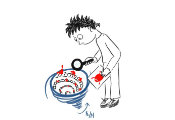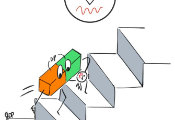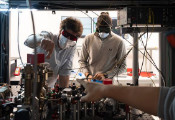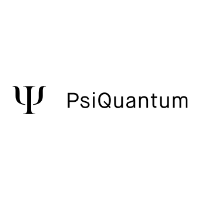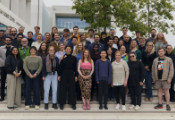Quantum Technique Could Transform Remote Sensing, Infrastructure Monitoring
April 16, 2025 -- A team of CU Boulder researchers has introduced a quantum sensing technique that could lead to improvements in how we monitor infrastructure, detect changes in the environment and conduct geophysical studies.
Led by Juliet Gopinath, Alfred T. and Betty E. Look Endowed Professor in the Department of Electrical, Computer and Energy Engineering, and physics doctoral student Gregory Krueper, the team used a quantum mechanics technique known as cascaded phase sensing, which enables a single sensor to measure multiple variables with extraordinary precision.
Current sensors typically measure temperature, strain or vibrations at a single point, limiting their effectiveness for large-scale monitoring. The new technique published in Physical Review A employs pulses of “squeezed” light—a quantum state that reduces measurement uncertainty beyond classical limits—to collect data from multiple locations along a single optical path.
A new era of sensing technology
The team’s breakthrough stems from an unexpected challenge.
Optical fiber sensors, which are widely used for monitoring infrastructure and environmental changes, often lose more than 99% of their original probe light, making it seem impossible to integrate quantum techniques. However, Gopinath and the research group found inspiration in two key sources.
“Gravitational wave detectors have successfully used quantum-enhanced light to improve their sensitivity,” Krueper said. “At the same time, recent advancement in classical fiber sensing introduced a method to divide the fiber into separate regions with embedded reflectors. By combining these ideas, and by collecting both reflected and transmitted light, we were able to make a distributed fiber quantum sensor.”
Their approach sends a series of quantum-enhanced light pulses through an optical fiber, using strategically placed reflectors to divide the fiber into distinct measurement zones.
Unlike traditional sensors that measure only one variable at a time, this method allows a single fiber to simultaneously capture precise data from multiple locations.
“By leveraging quantum mechanics, our method enables simultaneous, high-precision measurements at different points along a single sensor,” Gopinath said. “This could greatly improve applications like infrastructure integrity monitoring and environmental sensing.”
While the results are promising, a major hurdle remains: the quantum light source.
Current setups are large and costly. The next step for their research is to develop a portable, chip-based version of the light source, similar to the photonic technology found in modern smartphones. This advancement would pave the way for practical quantum sensors that can be used in the field.
Applications in environmental, geophysical sensing and infrastructure monitoring
Monitoring infrastructure—such as bridges, tunnels and pipelines—currently relies on traditional sensors placed at specific points to track structural health. These methods can be limited in scope and fail to provide a real-time, comprehensive view of an entire structure.
Cascaded phase sensing, as this project explored, addressed this gap by allowing a single optical fiber-based sensor to monitor multiple locations along its length with extreme precision. This continuous, high-resolution data collection could detect tiny vibrations or structural instabilities in real time.
Such advancements would allow engineers to proactively address maintenance needs, prevent failures and extend the lifespan of critical infrastructure, ultimately improving public safety and reducing costs.
The technique also has implications for environmental monitoring and geophysical studies. By placing sensors in natural settings, researchers could track subtle changes in temperature, pressure or seismic activity with unprecedented accuracy. This could improve early detection of earthquakes, monitor groundwater movement or study underground structures without invasive drilling.
According to Gopinath, this work represents a new paradigm for quantum sensing that could start an entire field of study.
“Many practical opportunities present themselves, ranging from neuroscience to seismic studies to energy infrastructure,” Gopinath said. “The work can provide a powerful method for sensitive remote sensing using quantum light and optical fibers.”

